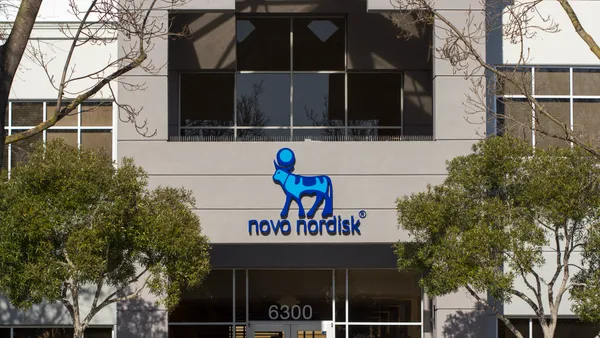E-Technologies: Across the Board Solutions VIEW on E-Solutions October 2007 The pharmaceutical industry will lose patient trust within 10 years unless it learns to adapt to changes in the way healthcare will be created, delivered, and managed. This is just one of the many predictions from a new investigation of the healthcare market undertaken by BT. According to BT’s pharmaceutical division research experts, by 2016 healthcare will become a commodity in the way that energy is today. Technology will provide a joined up patient service to meet individual health requirements and demands on a daily basis. Knowledge transfers of electronic record systems between hospitals, clinics, and physicians are already speeding up treatment times. “Pharmaceutical companies must create a direct dialogue with consumers if they want to become part of the new, joined-up healthcare network,” says Yury Rozenman, head of marketing, pharmaceutical sector, at BT. “As technology facilitates an increasingly close relationship between doctor and patients, pharmaceutical companies need to reposition themselves.” Patients will begin to expect an on-demand healthcare service as new technologies allow them to interact when it suits them. New developments, such as tele-health will provide virtual consultations that eliminate all but essential visits to hospitals and clinics. “The industry communicates more with lawyers, lobbyists, and doctors than increasingly aware patients, who will expect to be consulted on new drugs and treatments,” Mr. Rozenman says. “The pharmaceutical industry needs to adapt and build closer links with patients.” The industry appears to be taking heed and in an effort to improve a multitude of its business operations over the past few years pharmaceutical companies have increasingly looked at, and tapped into, technologies that automate production, process controls, security, safety, logistics, product authentication, marketing, sales, research, clinical operations — almost every aspect of its overall business operations. One of the most exciting developments in the industry in the past decade has been the ability to develop customer relationship management (CRM) systems based on the integration of an abundance of patient, customer, prescriber, economic, demographic, lifestyle, psychographic, DSS, and Internet data. There are dozens of vendors that provide counsel, tools, and technologies to support the pharmaceutical industry’s growing CRM initiatives, as companies have come to recognize the importance of developing a “relationship” with a targeted audience. At the core of these efforts is the need to establish a clear view of the customer, be it healthcare provider, patient, or care giver, or any combination thereof. According to industry insiders, understanding the entire customer base and all of the touch points in which customers make contact enables pharmaceutical companies to acquire new customers, offer timely incentives for increasing business with established customers, and plan for long-term relationships with the most profitable customers. Integrating Solutions There are several companies, large and small, such as Novo Nordisk, Novartis, AstraZeneca, and Reliant, that have solid and cohesive organizations and strategies around e-solutions. For example, the e-marketing group at Novo Nordisk is a center of excellence within the company. This recently formed functional area, headed by Craig DeLarge, associate director, eMarketing, collaborates with relevant stakeholders within and outside the company to provide strategic counsel and tactical development and execution in the areas of online, interactive, and relationship marketing. “Our goal is to create communications channels and environments where our various stakeholders can appropriately communicate with their customers wherever they happen to be within online digital channels,” he says. “We have a vision of taking the legacy assets that Novo Nordisk has in these areas and integrating them into a next-generation relationship marketing model for both patients and healthcare professionals. We are committed to providing best-in-class online experiences for people with diabetes, their healthcare providers, and their caregivers.” Integration is not without its hiccups, and as new technologies for a multitude of operations come online, companies will need to address just as many challenges. “The introduction of any new technology — or process for that matter — always faces some hurdles and many people shy away from using new technology if they feel that it is untested or unproven,” says John Varaklis, head of operations and innovation for transitional medicine, Novartis Pharmaceuticals Corp. “The key to overcoming these hurdles is communications. There are many good ideas that have failed because of the lack of communication along the way.” AstraZeneca recently selected an enterprisewide standard to automate the retrieval, delivery, and routing of content from a wide range of internal and external information sources to facilitate its integration needs. The new AstraZeneca service, based on Autonomy’s Intelligent Data Operating Layer (IDOL), also is expected to replace a number of rules-based legacy technologies, which are presently deployed within the company’s global intranet. AstraZeneca chose Autonomy’s IDOL platform to supply an internal intelligent information service for all users working across multiple internal applications, information sources, as well as content from numerous external news sources. As a world-leading company spending in excess of $11 million per day on research and development, it was vital for AstraZeneca that its employees had access to the most up-to-date and precisely relevant information available. Big pharma doesn’t have a lock on cutting-edge solution adoption. Reliant Pharmaceuticals, an emerging specialty pharmaceutical company, recently deployed a Web collaboration application to address enterprise communications needs across its organization. Delivered through Centra’s ASP service, Reliant Pharmaceuticals has been using Centra to train and communicate with its dispersed sales organization, collaborate with business partners, and accelerate the rollout of a number of enterprise applications, including the company’s 401K plan and a spend management application. Reliant also is working on programs to conduct online marketing focus groups using Centra. According to a Reliant spokesperson, the ability to respond more quickly to market changes, shorten cycle times for business processes, and empower employees with the tools they need to enhance performance continue to drive the company’s technology purchasing decisions. In the end, the beauty of technology is that it allows companies to be where the customers are, whether they are patients, healthcare providers, investigators, or clinical study participants. Web 2.0 Emerging tools and media are changing how marketing messages are being delivered and to whom. Physicians, while still a target audience, are being joined by patients, caregivers, and other stakeholders. After 10 years of direct-to-consumer (DTC) advertising and the growth of the U.S. Internet population, the question researchers at eMarketer are asking is not who is searching for health information online but rather who isn’t? Recently, pharmaceutical companies have begun to address how empowered “super” consumers are using blogs, message boards, video-sharing, and other digital media platforms to influence others and, ultimately, impact their brands. “These vehicles will continue to grow in importance and influence ultimate product success, but pharma companies will need to tread carefully in how they make use of them,” says Nicholas Landekic, president and CEO of PolyMedix Inc. “Many of these media fall under direct-to-consumer guidelines and are potentially very valuable, but must be used appropriately.” According to eMarketer, by 2011, the pharmaceutical category will account for 5% or $2.2 billion of Internet advertising. Growth will come from pharmaceuticals, hospitals, and other healthcare services, courtesy of the increasing influence of consumer-directed health plans. (For more information see chart on page 6.) Despite this projected growth, eMarketer analysts say most of the pharmaceutical industry hasn’t fully adopted Web 2.0, and by restricting company brand sites to simple online information centers, pharma marketers are missing opportunities to engage consumers and boost compliance. “So many Web-based vehicles continue to evolve, and with that evolution more people are being brought closer together and the breadth and depth of information exchange is expanding,” Mr. Landekic says. “But is the term Web 2.0 really a sea change in society, or a marketing buzzword? Lately, I have been pondering how the relatively new online phenomena of Web 2.0 and Second Life or virtual worlds are affecting and presenting opportunities for how we communicate with our customers online.” For many marketers in the industry, Web 2.0 is more than just a buzzword. Companies, and their healthcare marketing partners, are starting to embrace new media — social networks, blogs, and other nontraditional marketing communications tools. While many companies are gingerly stepping out of the old marketing box and into a new broadband arena, there are a few early adopters, such as Novo Nordisk, that have been tracking right along with consumer demand. According to Mr. DeLarge, Novo Nordisk has a distinct mission that goes beyond just providing innovative diabetes products for its customers; it extends to observing what it calls the triple bottom line. “The idea is that we need to be economically viable, socially responsible, and environmentally sustainable,” he says. “Our commitment to social responsibility in e-marketing can be seen in our unbranded diabetes education Website called Changing Life With Diabetes (changingdiabetes-us.com). Within this site, we have been exploring ways to allow people with diabetes to share effective practices with one another. Earlier this year, in collaboration with our patient services stakeholders, we launched our Voices of Diabetes initiative, a blog-like space within Changing Life With Diabetes that invites people with diabetes to submit stories about how they cope with diabetes. Although each story undergoes minor editing and medical, legal, and regulatory review, we have been able to retain the tone and spirit of the more than 200 stories submitted so far.” According to Sue Rago, associate director of patient services and professional relations at Novo Nordisk, the team is very pleased with the response it has received so far to the Voices of Diabetes feature. “The compelling and uplifting stories demonstrate the power of establishing a supportive community in assisting those coping with diabetes on a day-to-day basis,” she says. “We really believe that the user-generated content phenomenon that is characteristic of Web 2.0 is an opportunity for us to facilitate productive connections between and with our customers. We are watching to see how this initiative performs with an eye on how it might benefit other of our customer groups.” This year the company is experimenting with the use of audio podcasts and video in its healthcare professional education activities. “In collaboration with our diabetes brand marketing and market shaping stakeholders, we also launched NovoPod, a series of audio podcasts that are housed within novomedlink.com, our Website for healthcare professionals,” Mr. DeLarge says. “As to the use of video, our latest e-details on novomedlink.com have taken a decidedly key-opinion-leader-video-approach. These initiatives have increased the convenience of access to our live diabetes event content for the doctors we serve.” When asked to divulge some best practices related to working with new media, Mr. DeLarge says his group doesn’t vary too much from what they know already, which includes: understanding what the customers’ needs are; assuring that what they do is for the customer, their stakeholders, and the business, versus for the coolness of it; making sure there are mechanisms for measuring everything they do; assuring that they continue to get better and better at cross-silo functioning, especially with the brand management and regulatory/legal stakeholder groups; and assuring that they stay open to productive experimentation and the learning and innovation it yields. “Our goal is to create communications channels and environments where our various stakeholders can appropriately communicate with their customers wherever they happen to be within online digital channels,” Mr. DeLarge says. “We have a vision of taking the legacy assets that Novo Nordisk has in these areas and integrating them into a next-generation relationship marketing model for both patients and healthcare professionals. We are committed to providing best-in-class online experiences for people with diabetes, their treaters, and their caregivers.” Mr. Landekic also will be watching how the industry moves forward in this new media age, and how companies will handle regulatory issues. “Whether the industry likes it or not, regulatory oversight is needed here, just as with DTC,” he says. “Otherwise, there is the danger of sliding down the slippery slope to the ?snake oil salesmen’ practices of the 19th century, hawking products directly to consumers without accurately portraying the realistic clinical utility of a drug.” E-R&D BT’s investigation of future trends also outlines how technological advances will boost patient treatment, monitoring, and maintaining. For example, drug design and development processes will change beyond recognition as rapid virtual modeling replaces expensive and laborious lab work. Such moves could increase patient trust as treatment reaches patients faster and at lower cost. BT expects intelligent microchips and nanotechnologies to increase pharmaceutical compliance regimes with subdermal implants removing patient error as medication and microchips determine the precise level and timing of drug release for each individual patient. “In 10 years we could see nanotechnologies being sprayed or tattooed on to the skin to monitor health and alert practitioners to problems at an early stage,” Mr. Rozenman says. “Ultimately these technologies will be used to prevent illness, not to cure it, as healthcare becomes proactive not reactive.” Analysts at PricewaterhouseCoopers agree that new technologies will drive R&D. Transformational technological changes in the pharmaceutical industry will reshape the business strategies of pharmaceutical companies. The role of genetic-based diagnostics in the development of personalized medicines has already shortened the R&D cycle for those products. Further research into the human genome will open up a new world of opportunities in molecular science and new ways of looking at targets. These new technologies will be used to improve understanding of diseases and link genomic and clinical data. The development of molecular delivery platforms could speed the development of new products that leverage existing and approved platforms. The convergence of therapeutics and medical devices, which started in earnest with the drug-releasing stent, will continue and become increasingly sophisticated, improving efficacy and reducing the risk profile of many existing therapeutic agents. At Novartis Pharmaceuticals, considerable effort is being invested to assure the communication lines are open and working in the various groups involved and that new technologies to leverage the pervasive healthcare concept are being investigated and implemented. While Mr. Varaklis admits that there are some technical hurdles that pose ome limits on the full exploitation of the available new technologies and methodologies, there are plans in place to help correct these gaps over time. “Within the larger pharma organization at Novartis, many new technologies are still not as well-known, however, there is growing interest to learn more and see how the experience in early trials can be used in the later trials,” he says. “Our team is regularly providing the technical and experiential information to the entire organization to help bridge any possible gaps and further expand the use of technologies, such as interactive informed consent tools, wireless monitoring devices, and so on in the broader organization.” By Taren Grom, Editor PharmaLinx LLC, publisher of the VIEW, welcomes comments about this article. E-mail us at [email protected]. In the area of nontraditional and emerging media, we are investigating how the pharmaceutical industry is using virtual worlds such as Second Life, rich media channels like YouTube, and, of course, blogging and social networking. Craig DeLarge Novo Nordisk thought leaders n Craig A. DeLarge. Associate Director, eMarketing, Novo Nordisk Inc., Princeton, N.J.; Novo Nordisk is a focused healthcare company and a leader in diabetes care. For more information, visit novonordisk.com. n Nicholas Landekic. President and CEO, PolyMedix Inc., Radnor, Pa.; PolyMedix develops biomimetics for membrane protein and protein:protein targets. For more information, visit polymedix.com. n Sue Rago. Associate Director, Patient Services and Professional Relations, Novo Nordisk Inc., Princeton, N.J.; Novo Nordisk is a focused healthcare company and a leader in diabetes care. For more information, visit novonordisk.com. n Yury Rozenman. Head of Marketing, Pharmaceutical Sector, BT, London; BT provides communications solutions and services with principal activities in networked IT services, local, national, and international telecommunications services, and higher-value broadband and Internet products and services. For more information, visit btplc.com. n John Varaklis. Head of Operations and Innovation for Transitional Medicine, Novartis Pharmaceuticals Corp., East Hanover, N.J.; Novartis discovers, develops, and successfully markets innovative products to cure diseases, ease suffering, and enhance quality of life. For more information, visit novartis.com. In 2016, there will be closer, stronger links among all players in the healthcare network. Pharma companies must start the ball rolling now by embracing the changes and opportunities. To do nothing is to run the risk of becoming mute within the highly networked and converged world of communications. Yuri Rozenman BT Lately, I have been pondering how the relatively new online phenomena of Web 2.0 and Second Life or virtual worlds are affecting and presenting opportunities for how we communicate with our customers online. Nicholas Landekic PolyMedix Inc. John Varaklis Novartis The introduction of any new technology — or process for that matter — always faces some hurdles and many people shy away from using new technology if they feel that it is untested or unproven. The key to overcome these hurdles is communication. There are many good ideas that have failed due to the lack of communication along the way. U.S. Pharmaceutical and Healthcare Industry Online Advertising Spending, 2006-2011 % of Spending total* % change 2006 $820 4.9% 31.2% 2007 $975 4.5% 18.9% 2008 $1,190 4.1% 22.1% 2009 $1,530 4.5% 28.6% 2010 $1,950 5.0% 27.5% 2011 $2,200 5.0% 12.8% Note: Dollars are in millions and include drug manufacturers and marketers, doctors, hospitals, and other entities that deliver health services, such as health maintenance organizations. * of total U.S. online advertising spending. Source: eMarketer, New York, August 30, 2007. For more information, visit emarketer.com. EDC Poised to Disrupt Life-Sciences Industry HealtH industry insights, an IDC company, estimates investment in electronic data capture (EDC) solutions to increase at a 14.7% compound annual growth rate (CAGR) and total more than $3.1 billion for 2006 to 2011. Chris Connor, the report’s author, also predicts that 2007 is a tipping point as the adoption rate for EDC nearly doubles from 24.2% in 2005 to 45.2% in 2007. “EDC is the most disruptive technology to enter clinical development since the introduction of the personal computer itself,” says Mr. Connor, senior research analyst at Health Industry Insights. “This industry has relied on paper-based processes for decades, and we’re not seeing the scalability. Today, we’re on the verge of an explosive growth for EDC, and we expect the industry will never be the same.” According to Mr. Connor’s report, EDC, a software-based solution designed to assist in the collection and management of clinical trial data, will attract a significant rise in adoption across all stages of clinical trials. He also estimates that by the end of this year, almost half (45%) of all new clinical trials will be initiated using EDC. “The life-science industry is undergoing a fundamental shift away from batch processes where clinical data recorded on paper can be locked up for weeks,” Mr. Connor says. “EDC enables life-science companies to conduct adaptive clinical trials that operate in real time.” The in-depth analysis also identifies key factors impacting EDC adoption and spending today. Issues, such as investment trends and outsourcing, subscription pricing, integration with electronic health records (EHRs) and more, are highlighted in the report as major catalysts for change. Source: Health Industry Insights, an IDC company, Framingham, Mass. For more information, visit idc.com.
An article from


E-Technologies: Across the Board Solutions
Filed Under:
Commercialization








